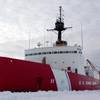US Marine Highways to Help Prepare for the Future
With America's population expected to grow by 70 million over the next 30 years, moving the goods that enrich our lives --and the freight that fuels our economy-- will be a key challenge. As our Beyond Traffic draft framework indicates, by 2045, the volume of goods on our roads, rail, air, and water will increase 45 percent or more.
Because tomorrow's looming increase will pose a significant burden on our transportation system, we must prepare to handle that freight now by developing and investing in solutions today. The good news is that DOT is working to do just that.
Our Nation’s navigable waterways offer us a terrific, underused resource, and the Maritime Administration’s Marine Highway Program works to incorporate that excess capacity into the U.S. transportation system --especially where marine transportation services present the most efficient and sustainable freight option. Continued development and investment along these 22 all-water Marine Highway Routes will provide more choices to shippers, help alleviate road and rail congestion, and accommodate future freight growth.
Just last week, Secretary Foxx designated three new marine highway projects aimed at making these waterborne routes seamless extensions of America’s transportation system and helping move us Beyond Traffic.
The Mississippi and Illinois Rivers --the M-55 and M-35 Highways-- connecting Chicago and Minneapolis to New Orleans, will serve as the primary routes for a developing container-on-barge service.
The M-95 in New York and New Jersey will see the expansion of two existing services that will provide access east of the Hudson River for freight arriving and departing the Port Newark Container Terminal.
For the DC area and my fellow commuters, the M-495 Potomac River Commuter Ferry Project offers the promise of connecting work and residential centers located along the Potomac, Occoquan, and Anacostia Rivers, providing a waterborne alternative for moving passengers and freight within the region.
In addition to applying innovation to solve an important transportation challenge, these projects also highlight the strong partnership between both public and private entities. Public leaders and industry stakeholders have partnered with some of our largest shippers --including Walmart, Home Depot, Hardy Logistics, and the Illinois Soybean Association-- to develop sustainable Marine Highway services and bring commerce back to our rivers and inland waterways.
But we need to take the next step. We’re not going to inherit the system we want. We —and I mean all stakeholders— will have to create it.
Together, we need to make decisions about our future and take real actions that focus on continuing to look for partnerships; continuing to invest in projects that create multi-modal options for shippers; and continuing to support opportunities for economic growth and jobs.
The three projects announced last week are a perfect example of these principles in action, and we look forward to working with stakeholders to develop more of them.










